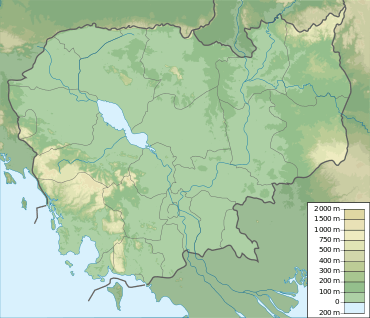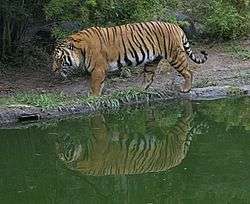Cardamom Mountains
| Cardamom Mountains | |
|---|---|
|
Aerial view of an illegal logging camp in the Cardamom Mountains in Koh Kong Province | |
| Highest point | |
| Peak | Phnom Aural |
| Elevation | 1,813 m (5,948 ft) |
| Dimensions | |
| Length | 300 km (190 mi) NW/SE |
| Width | 70 km (43 mi) NE/SW |
| Geography | |
 Krâvanh Mountains in Cambodia | |
| Country | Cambodia and Thailand |
| Range coordinates | 12°00′N 103°15′E / 12.000°N 103.250°ECoordinates: 12°00′N 103°15′E / 12.000°N 103.250°E |
| Geology | |
| Age of rock | Cambrian[1] |
| Type of rock | Metaconglomerate |
The Krâvanh Mountains, literally the "Cardamom Mountains" (Khmer: ជួរភ្នំក្រវាញ, Chuor Phnom Krâvanh; Thai: ทิวเขาบรรทัด, Thio Khao Banthat, pronounced [tʰīw kʰǎw bān.tʰát]), is a mountain range in the south west of Cambodia and Eastern Thailand.
The silhouette of the Cardamom Mountains appears in the provincial seal of Trat Province in Thailand.[2]
Location and description
The mountain range extends along a southeast-northwest axis from Koh Kong Province on the Gulf of Thailand to the Veal Veang District in Pursat Province, and is extended to the southeast by the Dâmrei (Elephant) Mountains.[3] The northwestern end of the range in Chanthaburi Province, Thailand, appears also as the 'Soi Dao Mountains' (Khao Soi Dao) and as 'Chanthaburi Range' in some maps.
Dense tropical rainforest prevails on the wet western slopes which annually receive from 150 to 200 inches (3,800–5,000 mm) of rainfall. By contrast, only 40 to 60 inches (1,000 to 1,500 mm) fall in places like Kirirom National Park on the wooded eastern slopes in the rain shadow facing the interior Cambodian plain. On the eastern slopes, cardamom and pepper are still grown commercially.
Summits
The highest elevation of the Cardamom Mountains is Phnom Aural in the northeast at 1,813 metres (5,948 ft). This is also Cambodia's highest peak. Phnom Samkos (1,717 m), Phnom Tumpor (1,516 m) and Phnom Kmoch (1,220 m) are other important summits.
History
The mountains contain many historic sites from the 15th- to 17th-century, containing 60 cm exotic ceramic jars and rough-hewn log coffins set out on remote, natural rock ledges, scattered around the mountains.[4] The jar burials are a unique feature of this region, and forms a previously unrecorded burial practice in Khmer cultural history. Local legends suggest the bones are the remains of Cambodian royalty.
This largely inaccessible mountainrange formed one of the last strongholds of the Khmer Rouge, driven out by Vietnamese forces during the Cambodian–Vietnamese War. The Thai border to the west, acted as a conduit for Chinese support and, eventually, a sanctuary for fleeing Khmer fighters and refugees.[5] The inaccessibility of the hills has also helped to preserve the primeval forest and ecosystems of the area relative intact. In 2002, however, a transborder highway to Thailand was completed south of the Cardamoms, along the coast. The highway has fragmented habitats for large mammals such as elephants, big cats and monkeys. The highway has also opened up for agricultural slash-and-burn projects and opportunistic poaching for endangered animals, all degrading the natural value and the forests ecosystems.[6]
Tourism is relatively new to the Cardamom Mountains. In 2008, Wildlife Alliance launched a community-based ecotourism program in the village of Chi-Phat, marketed as the "gateway to the Cardamoms".[7] Tourist visitors to Chi-Phat continue to grow and the community is regarded as a model for community-based ecotourism, with approximately 3,000 annual visitors generating more than $US 150,000 for the local community.[8]
International conservation organizations working in the area includes Wildlife Alliance,[9] Conservation International,[10] and Fauna and Flora International.[11] In 2016, the southern slopes of the Cardamom Mountains were designated as a new national park; Southern Cardamom National Park.[6] It appears, however, that rampant illegal poaching is continuing nonetheless.[12]
Ecology
These relatively isolated mountains now form an important tropical moist broadleaf forest ecoregion, the Cardamom Mountains Moist Forests Ecoregion.[13] One of the largest and still mostly unexplored forests in southeast Asia, it is separated from other rainforests in the region by the large Khorat Plateau to the north. The Vietnamese Phú Quốc island off the coast of Cambodia has similar vegetation and is included in the ecoregion.[13]
Most of the region is covered in evergreen rain forest with a different type of thick evergreens above 700m and areas of dwarf conifer Dacrydium elatum forest on the southern slopes of the Elephant Mountains and an area of Tenasserim pine dominated forest on the Kirirom plateau. Hopea pierrei, an endangered canopy tree rare elsewhere, is relatively abundant in the Cardamom Mountains. Other angiosperm tree species are Anisoptera costata, Anisoptera glabra, Dipterocarpus costatus, Hopea odorata, Shorea hypochra, Caryota urens and Oncosperma tigillarium.[14] Other conifers include Pinus kesiya, Dacrycarpus imbricatus, Podocarpus neriifolius, P. pilgeri and Nageia wallichiana.[15] The southernmost on Earth natural habitats of genus Betula (species Betula alnoides) are situated in the northern part of Cardamom Mountains.[16]
Fauna
The moist climate and undisturbed nature of the rocky mountainsides appears to have allowed a rich variety of wildlife to thrive, although the Cardamom and Elephant Mountains are poorly researched and the wildlife that is assumed to be here remains to be catalogued. They are thought to be home to over 100 mammals such as the large Indian civet and banteng cattle, and most importantly the mountains are thought to shelter at least 62 globally threatened animal species and 17 globally threatened trees, many of them endemic to Cambodia.[17] Among the animals are fourteen endangered and threatened mammal species, including the largest population of Asian elephant in Cambodia and possibly the whole of Indochina although this still needs to be proved. Other mammals, many of which are threatened, include Indochinese tiger, clouded leopard (Pardofelis nebulosa), dhole (a wild dog) (Cuon alpinus), gaur (Bos gaurus), banteng (Bos javanicus), the disputed kting voar (Pseudonovibos spiralis), Malayan sun bear, pileated gibbon (Hylobates pileatus), Sumatran serow (Capricornis sumatraensis), Sunda pangolin and the Tenasserim white-bellied rat.[18] There are at least 34 species of amphibians, three of them described as new species to science from here.[19]
The rivers are home to both Irrawaddy and humpback dolphins and are home to some of the last populations on Earth of the very rare Siamese crocodiles and the only nearly extinct northern river terrapin, or royal turtle remaining in Cambodia. While the forests are habitat for more than 450 bird species, half of Cambodia’s total of which four, the chestnut-headed partridge, Lewis's silver pheasant (Lophura nycthemera lewisi), the green peafowl (Pavo muticus) and the Siamese partridge (Arborophila diversa) are endemic to these mountains. A reptile and amphibian survey led in June 2007 by Dr Lee Grismer of La Sierra University in Riverside, California, US and the conservation organisation Fauna and Flora International uncovered new species, such as a new Cnemaspis gecko, C. neangthyi.[17][20]
Protected areas
The human population of the Cardamom Mountain Range although very small is extremely poor. Threats to the biological diversity of the region include habitat loss due to illegal logging, wildlife poaching, and forest fires caused by slash-and-burn agriculture. While the Cambodian forests in the Cardamom Mountains are fairly intact, the section in Thailand has been badly affected.
About a third of the ecoregion has been designated as protected areas,[21] but the level of active protection in all parks in the mountains has been criticised.
Cambodia
- Phnom Samkos Wildlife Sanctuary
- Phnom Aural
- Preah Monivong National Park
- Botum-Sakor National Park
- Samlaut Multiple Use Area
- Southern Cardamom National Park
Thailand
- Namtok Khlong Kaeo National Park
- Khao Khitchakut National Park
- Namtok Phlio National Park
- Khao Chamao Khao Wong National Park
- Khao Soi Dao Wildlife Sanctuary[22]
- Klong Kruewai Chalerm Prakiat Wildlife Sanctuary
- Khao Ang Rue Nai Wildlife Sanctuary.
Tourism
The Cardamom Mountains are an emerging tourist destination.
The village of Chi Phat runs a Community-Based Eco-Tourism project with the support of conservation NGO, Wildlife Alliance. Previously a logging and hunting community, villagers now make sustainable income through homestays, multiple day guided treks to natural and cultural sites, mountain bike, boat and bird watching tours.
The Wildlife Release Station in Koh Kong Province is a release site for animals rescued from the illegal wildlife trade in Cambodia by the NGO Wildlife Alliance. Binturong, porcupine, pangolins, civets, macaques and an array of birds are among the many species that have been released on site. The station was opened to tourists in December 2013, offering guests an insight into the workings of a wildlife rehabilitation and release site while staying in jungle chalets and enjoying Cambodian hospitality. Activities offered can include feeding resident wildlife, jungle hiking, radio tracking and setting camera traps to monitor released wildlife.
Wild Animal Rescue (WAR Adventures Cambodia) also organize a wide range of deep jungle activities from the family trekking to the hardcore RAID adventure, jungle orientation and survival training course, even animals and human tracking course, all in the region of Sre Ambel in the South-west of the Cardamom mountains.
See also
- Central Cardamom Mountains
- Dâmrei Mountains
- Cardamom Khmer, a variant of the Khmer language spoken in these mountains
- K5 Plan
References
- ↑ Cambodia Ecological Zonation
- ↑ Seals of The Provinces of Thailand
- ↑ Cardamom and Elephant Mountains (Cambodia) Archived 2012-03-25 at the Wayback Machine.
- ↑ ANU - Ceramic Jars
- ↑ Fiona Terry (12 April 2013). Condemned to Repeat?: The Paradox of Humanitarian Action. Cornell University Press. pp. 118–. ISBN 0-8014-6863-9.
- 1 2 "Southern Cardamom Forest Registered as a National Park!". Wildlife Alliance. 18 May 2016. Retrieved 14 August 2018.
- ↑ Lonely Planet Chi Phat
- ↑ Reimer, J. K., & Walter, P. (2013). How do you know it when you see it? Community-based ecotourism in the Cardamom Mountains of southwestern Cambodia. Tourism Management, 34, 122-132.
- ↑ Wildlife Alliance Forest Protection Program
- ↑ Conservation International Cambodia Program
- ↑ Fauna & Flora International Cardamoms Mountain Program
- ↑ "Over 100,000 snares found in Cardamom National Park". The Phnom Penh Post. 25 May 2018. Retrieved 14 August 2018.
- 1 2 "Cardamom Mountains Moist Forests". Terrestrial Ecoregions. World Wildlife Fund.
- ↑ World Wildlife Fund - Cardamom Mountains Moist Forests
- ↑ "Conifers of Cambodia, Lao PDR and Vietnam". Science/Genetics & Conservation/Conifer Conservation. Royal Botanic Garden Edinburgh. 2010. Archived from the original on 29 November 2007. Retrieved 19 April 2012.
- ↑ Forest Vegetation of Cardamom Mountains, Cambodia. A.N. Kuznetsov, S.P. Kuznetsova. BULLETIN OF MOSCOW SOCIETY OF NATURALISTS. BIOLOGICAL SERIES. 2012. Vol. 117, part 5, 2012 September – October, p. 39—50 (in Russian)
- 1 2 BBC News, "New cryptic gecko species is discovered in Cambodia ", 24 March 2010: accessed 24 March 2010.
- ↑ CeroPath - Niviventer tenaster Thomas, 1916
- ↑ Ohler, A.; S. R. Swan; J. C. Daltry (2002). "A recent survey of the amphibian fauna of the Cardamom Mountains, Southwest Cambodia with descriptions of three new species" (PDF). Raffles Bulletin of Zoology. 50: 465–481.
- ↑ Grismer, J. L.; Grismer, L. L.; Chav, T. (2010). "New Species of Cnemaspis Strauch 1887 (Squamata: Gekkonidae) from Southwestern Cambodia". Journal of Herpetology. 44: 28. doi:10.1670/08-211.1.
- ↑ Protected areas in Cambodia
- ↑ Khao Soi Dao Wildlife Sanctuary
External links
| Wikimedia Commons has media related to Cardamom Mountains. |
